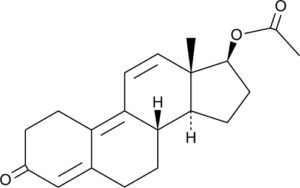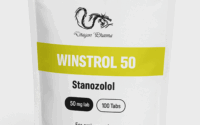Trenbolone Acetate
 What is Trenbolone Acetate?
What is Trenbolone Acetate?
Trenbolone Acetate is an anabolic-androgenic steroid (AAS) that has garnered significant attention and debate within the realms of bodybuilding and competitive sports. Known for its potent properties and dramatic effects on muscle mass and strength, Trenbolone Acetate illustrates a complex interplay between the quest for physical excellence and the ethical, health-related issues accompanying steroid use.
At its core, Trenbolone Acetate is a modified derivative of Nandrolone, a naturally occurring steroid hormone. The modifications imbued within Trenbolone’s structure grant it a profile of increased anabolic and androgenic activity compared to its progenitor.
The mechanism of action of Trenbolone Acetate, like other anabolic steroids, involves the binding to and activation of androgen receptors within the body. This activation initiates a cascade of biological processes that stimulate protein synthesis, nitrogen retention, and the suppression of catabolic processes, which collectively contribute to muscle growth and strength gains. Additionally, Trenbolone Acetate uniquely has a strong binding affinity for the glucocorticoid receptor, further potentiating its muscle-building and fat-burning abilities.
Trenbolone A is revered for its ability to promote substantial gains in lean muscle mass without the accompaniment of water retention. This quality makes it especially favorable among bodybuilders looking to achieve a hard, defined physique. Moreover, Trenbolone’s androgenic effects can lead to significant improvements in strength, which are invaluable during periods of training and competition.
Most importantly
However, the potent effects of Trenbolone Acetate come with a litany of possible side effects that raise considerable health concerns. These can range from relatively mild issues such as oily skin, acne, and accelerated hair loss in predisposed individuals, to more severe impacts such as liver toxicity, cardiovascular strain, and adverse mental health effects like aggression and mood swings. Importantly, due to its potent androgenic properties, Trenbolone A presents a high risk of virilization (the development of masculine features) in women, making it an especially hazardous choice for female athletes.
The use of such drugs creates an uneven playing field, disadvantaging those who choose to compete naturally. Furthermore, the widespread non-medical use of Trenbolone Acetate perpetuates a cycle of dependency and health risks, fueled by societal pressures and the pursuit of an idealized physique.
From a legal standpoint, Tren A is classified as a Schedule III controlled substance in the United States under the Controlled Substances Act, indicating a potential for abuse and dependency.
In conclusion, Trenbolone Acetate represents a dichotomy within the quest for physical enhancement. On one hand, its powerful anabolic and androgenic effects offer the potential for unparalleled gains in muscle mass and strength, coveted by bodybuilders and athletes alike. On the other hand, the serious health risks, ethical dilemmas, and legal implications associated with its use highlight a darker aspect of performance enhancement. It serves as a cautionary tale of the lengths to which individuals may go in pursuit of physical perfection and the complex implications of doing so. The discussions surrounding Trenbolone Acetate touch on deeper societal issues relating to body image, sportsmanship, and the prioritization of health over achievements.
More info:


